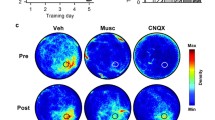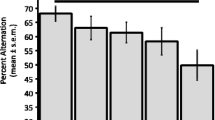Abstract
The effects of both systemic and intracerebroventricular administration of mecamylamine, a nicotinic antagonist, were tested on the Morris water maze performance of rats. In experiment 1, mecamylamine (0, 3, and 10 mg/kg, IP) was administered before daily training sessions on the Morris water maze, a task in which rats use environmental cues to learn the location of an invisible escape platform in a large pool of water. The escape latencies of rats given the higher dose of mecamylamine were significantly longer than the latencies of rats given either saline or the peripherally-acting nicotinic antagonist hexamethonium (10 mg/kg). Analysis of search patterns during a free swim trial conducted in the absence of an escape platform confirmed the disruptive effects of the higher dose of mecamylamine. Similar drug effects were not observed when these rats were trained to a visible platform, and mecamylamine did not affect the retrieval of spatial information in well-trained rats. In experiment 2, similar effects were observed with ICV administration of mecamylamine (0, 10, 30, and 100 µg). The two higher doses increased escape latencies during the last day of place training and all three doses significantly impaired performance on a free swim. No significant effects were noted on subsequent training to a visible platform, and only the highest dose marginally impaired the retrieval of spatial information in well-trained animals. Thus, mecamylamine appears to impair the acquisition of spatial information in the Morris water maze but does not affect retrieval of previously acquired spatial information at comparable doses.
Similar content being viewed by others
References
Bammer G (1982) Pharmacological investigations of neurotransmitter involvement in passive avoidance responding: a review and some new results. Neurosci Biobehav Rev 6:247–296
Bartus RT, Dean RL, Beer B, Lippa AS (1982) The cholinergic hypothesis of geriatric memory dysfunction. Science 217:408–417
Clarke PBS (1987) Nicotine and smoking: a perspective from animal studies. Psychopharmacology 92:135–143
Clarke PBS, Fibiger HC (1990) Reinforced alternation performance is impaired by muscarinic but not by nicotinic receptor blockade in rats. Behav Brain Res 36:203–207
Coyle JT, Price DL, DeLong MR (1983) Alzheimer's disease: a disorder of cortical cholinergic innervation. Science 219:1184–1190
Dilts SL, Berry CA (1967) Effect of cholinergic drugs on passive avoidance in the mouse. J Pharmacol Exp Ther 158:279–285
Elrod K, Buccafusco JJ (1988) Selective central nicotinic receptor blockade inhibits passive, but not active, avoidance learning in rats. Soc Neurosci Abstr 14:57
Flood JF, Landry DW, Jarvik ME (1981) Cholinergic receptor interactions and their effects on long-term memory processing. Brain Res 215:177–185
Haroutunian V, Barnes E, Davis KL (1985) Cholinergic modulation of memory in rats. Psychopharmacology 87:266–271
Levin ED, Castonguay M, Ellison GD (1987) Effects of the nicotinic receptor blocker, mecamylamine, on radial-arm maze performance in rats. Behav Neural Biol 48:206–212
Levin ED, McGurk SR, South D, Butcher LL (1989) Effects of combined muscarinic and nicotinic blockade on choice accuracy in the radial-arm maze. Behav Neural Biol 51:270–277
Levin ED, Lee C, Rose JE, Reyes A, Ellison G, Jarvik M, Gritz E (1990a) Chronic nicotine and withdrawal effects on radial-arm maze performance in rats. Behav Neural Biol 53:269–276
Levin ED, Rose JE, McGurk SR, Butcher LL (1990b) Characterization of the cognitive effects of combined muscarinic and nicotinic blockade. Behav Neural Biol 53:103–112
Morris RGM (1981) Spatial localization does not require the presence of local cues. Learn Motiv 12:239–260
Oliverio A (1966) Effects of mecamylamine on avoidance conditioning and maze learning of mice. J Pharmacol Exp Ther 154:350–356
Riekkinen P Jr, Sirviö J, Aaltonen M, Riekkinen P (1990) The effects of concurrent manipulations of nicotinic and muscarinic receptors on spatial and passive avoidance learning. Pharmacol Biochem Behav 37:405–410
Robinson GS Jr, Crooks GB Jr, Shinkman PG, Gallagher M (1989) Behavioral effects of MK-801 mimic deficits associated with hippocampal damage. Psychobiology 17:156–164
Warburton DM, Wesnes K (1984) Drugs as research tools in psychology: cholinergic drugs and information processing. Neuropsychobiology 11:121–132
Whitehouse PJ, Martino AM, Antuono PG, Lowenstein PR, Coyle JT, Price DL, Kellar KJ (1986) Nicotinic acetylcholine binding sites in Alzheimer's disease. Brain Res 371:146–151
Author information
Authors and Affiliations
Rights and permissions
About this article
Cite this article
Decker, M.W., Majchrzak, M.J. Effects of systemic and intracerebroventricular administration of mecamylamine, a nicotinic cholinergic antagonist, on spatial memory in rats. Psychopharmacology 107, 530–534 (1992). https://doi.org/10.1007/BF02245267
Received:
Revised:
Issue Date:
DOI: https://doi.org/10.1007/BF02245267




